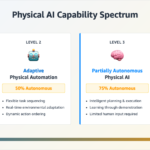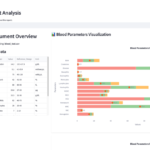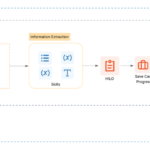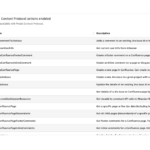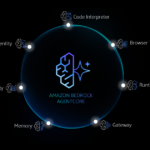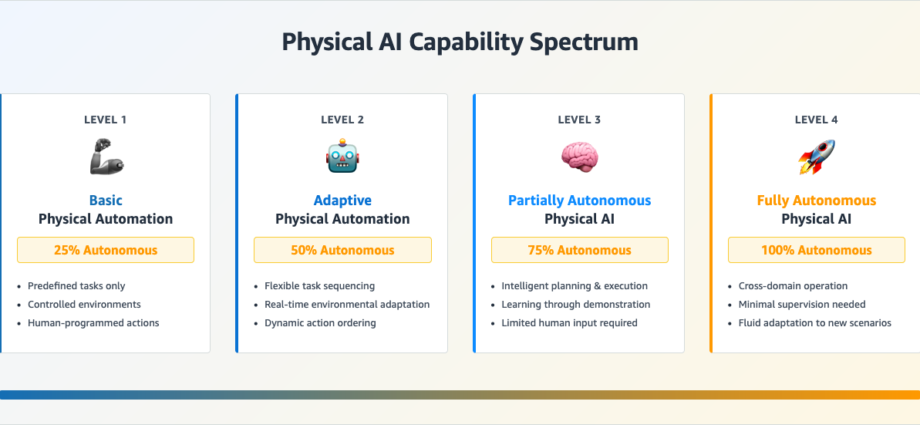The convergence of artificial intelligence with physical systems marks a pivotal moment in technological evolution. Physical AI, where algorithms transcend digital boundaries to perceive, understand, and manipulate the tangible world, will fundamentally transform how enterprises operate across industries. These intelligent systems bridge the gap between digital intelligence and physical reality, unlocking unprecedented opportunities for efficiency and innovation. For many organizations, this opens the door to entirely new ways to delight their customers and, in turn, transform entire industries.
To accelerate this transformation, the AWS Generative AI Innovation Center, MassRobotics, and NVIDIA launched the Physical AI Fellowship, providing crucial support to startups developing next-generation robotics and automation solutions. We are pleased to be working with our first cohort fellows:
- Bedrock Robotics – provides same-day hardware and software installation to provide autonomy to existing construction equipment fleets
- Blue Water Autonomy – integrating hardware, software, and AI to enable uncrewed ships to operate on the open ocean for months at a time
- Diligent Robotics – develop foundation models for autonomous humanoid robots in dynamic, human-facing environments
- Generalist AI – developing end-to-end AI foundation models toward general-purpose robots, starting with a focus on dexterity
- RobCo – offering modular hardware and a no-code system to automate tasks such as machine tending, palletizing, dispensing, or welding without upfront investment or specialist expertise
- Tutor Intelligence – building AI-powered robots to help manufacturers and warehouses obtain immediate returns on investment
- Wandercraft – developing exoskeletons to help with rehabilitation and restoring walking ability at home and in outpatient centers
- Zordi – combining AI, robotics, and machine learning to innovate greenhouse agriculture
For businesses and public sector organizations, this convergence of AI and physical systems goes beyond incremental improvements, fundamentally rethinking what’s possible in their operations and customer experiences.
The Physical AI spectrum: from automation to true intelligence

As organizations evaluate their Physical AI initiatives, understanding where different solutions fall on the capability spectrum is crucial for strategic planning. Each level represents a distinct leap in autonomy and sophistication:
- Level 1: Basic Physical Automation: This foundational stage involves systems that perform predefined tasks in tightly controlled environments. Think of industrial robots on assembly lines—highly efficient, but rigid and entirely dependent on human programming and oversight.
- Level 2: Adaptive Physical Automation: At this stage, systems gain flexibility in task sequencing. While individual actions are still preprogrammed, they can adjust their order based on real-time environmental cues. Collaborative robots that change behavior when humans are nearby is a prime example.
- Level 3: Partially Autonomous Physical AI: Here, systems demonstrate intelligent behavior, including planning, executing, and adapting tasks with limited human input. Robots that learn new processes through demonstration highlight this emerging autonomy.
- Level 4: Fully Autonomous Physical AI: The most advanced level features systems capable of operating across varied domains with minimal supervision. These systems adapt fluidly to new scenarios and environmental changes. Although most commercial solutions remain at Levels 1 or 2, momentum toward full autonomy is accelerating.
Enabling technologies: the building blocks of Physical AI
The progression from basic automation to full autonomy requires sophisticated technological foundations. Several key innovations are driving this evolution:
- Advanced control theory facilitates precise and reliable actuation.
- High-fidelity perception models, powered by multimodal sensors, enable machines to interpret complex environments.
- Edge AI accelerators support real-time inference at the point of action, crucial for latency-sensitive tasks.
- Foundation models, trained on multimodal datasets, help provide generalizable intelligence across domains.
- Digital twin systems play a pivotal role in enabling simulation, validation, and optimization of physical systems before real-world deployment, significantly accelerating development cycles.
Industry forces and investment momentum
Physical AI sits at the intersection of multiple high-growth industries, with the AI Robots sector alone projected to reach a staggering $124.26 billion by 2034. Alongside this, the closely related Digital Twin Technology industry is set to hit an even more impressive $379 billion in the same timeframe. These projections signal a fundamental shift in how enterprises approach automation, efficiency, and digital transformation.
Investors are keenly aware of this potential, focusing their attention on several key themes within the Physical AI space. Humanoid robotics has emerged as a particularly exciting frontier, with startups securing substantial funding rounds to develop general-purpose robotic workers capable of seamlessly operating in environments designed for humans. Simultaneously, there’s growing interest in foundation models for robotics – the development of sophisticated “robot brains” that can adapt to various tasks and control diverse robotic systems. This push towards more flexible, intelligent systems is complemented by continued investment in vertical-specific applications, where companies are leveraging Physical AI to address acute industry challenges, from streamlining warehouse logistics to revolutionizing agricultural practices. The breadth of Physical AI’s potential is further demonstrated by emerging applications in fields as diverse as surgical robotics, autonomous delivery systems, and advanced defense technologies. This expansion into new domains underscores the versatility and transformative power of Physical AI across sectors.
Real-world impact: quantifying the Physical AI transformation
While investment trends signal strong future potential, Physical AI is already delivering concrete results across industries. For example, Amazon’s supply chain has boosted efficiency by 25% through intelligent automation, while Foxconn cut manufacturing deployment times by 40%. In healthcare, AI-assisted procedures have led to 30% fewer complications and 25% shorter surgery durations, showcasing transformative outcomes.
According to a 2024 AI in manufacturing & energy report, 64% of manufacturers using AI in production already report positive ROI, with nearly one-third expecting returns of $2 to $5 for every dollar invested. These gains translate into efficiency improvements between 20-40%, cost savings of 15-30%, and the rise of innovative business models like Robot-as-a-Service.
In retail, digital twins are being used to explore the impact of different store layouts on shopper behavior and to test the integration of Physical AI with autonomous inventory management systems, helping retailers optimize their physical spaces and operations. Meanwhile, agriculture benefits from advancements in precision farming, crop monitoring, and automated harvesting—further highlighting Physical AI’s broad and growing impact.
The next frontier
The impact of Physical AI is already evident across industries, with organizations moving well beyond proofs-of-concept to delivering measurable business value. For participating cohorts, the Physical AI Fellowship will play a key role in helping innovative startups accelerate the path from research to commercial applications of this emerging technology. For enterprises of different sizes and sectors, successful integration of AI with physical systems will define industry leaders in the decade to come.
Learn more:
Learn more about the Generative AI Innovation Center and how we provide expert tailored support from experimentation to production.
About the authors
 Sri Elaprolu is a technology leader with over 25 years of experience spanning artificial intelligence, machine learning, and software engineering. As Director of the AWS Generative AI Innovation Center, Sri leads a global team of ML scientists and engineers applying the latest advances in generative AI to solve complex challenges for enterprises and the public sector.
Sri Elaprolu is a technology leader with over 25 years of experience spanning artificial intelligence, machine learning, and software engineering. As Director of the AWS Generative AI Innovation Center, Sri leads a global team of ML scientists and engineers applying the latest advances in generative AI to solve complex challenges for enterprises and the public sector.
 Alla Simoneau is a technology and commercial leader with over 15 years of experience, currently serving as the Emerging Technology Physical AI Lead at Amazon Web Services (AWS), where she drives global innovation at the intersection of AI and real-world applications. With over a decade at Amazon, Alla is a recognized leader in strategy, team building, and operational excellence, specializing in turning cutting-edge technologies into real-world transformations for startups and enterprise customers.
Alla Simoneau is a technology and commercial leader with over 15 years of experience, currently serving as the Emerging Technology Physical AI Lead at Amazon Web Services (AWS), where she drives global innovation at the intersection of AI and real-world applications. With over a decade at Amazon, Alla is a recognized leader in strategy, team building, and operational excellence, specializing in turning cutting-edge technologies into real-world transformations for startups and enterprise customers.
 Paul Amadeo is a seasoned technology leader with over 30 years of experience spanning artificial intelligence, machine learning, IoT systems, RF design, optics, semiconductor physics, and advanced engineering. As Technical Lead for Physical AI in the AWS Generative AI Innovation Center, Paul specializes in translating AI capabilities into tangible physical systems, guiding enterprise customers through complex implementations from concept to production. His diverse background includes architecting computer vision systems for edge environments, designing robotic smart card manufacturing technologies that have produced billions of devices globally, and leading cross-functional teams in both commercial and defense sectors. Paul holds an MS in Applied Physics from the University of California, San Diego, a BS in Applied Physics from Caltech, and holds six patents spanning optical systems, communication devices, and manufacturing technologies.
Paul Amadeo is a seasoned technology leader with over 30 years of experience spanning artificial intelligence, machine learning, IoT systems, RF design, optics, semiconductor physics, and advanced engineering. As Technical Lead for Physical AI in the AWS Generative AI Innovation Center, Paul specializes in translating AI capabilities into tangible physical systems, guiding enterprise customers through complex implementations from concept to production. His diverse background includes architecting computer vision systems for edge environments, designing robotic smart card manufacturing technologies that have produced billions of devices globally, and leading cross-functional teams in both commercial and defense sectors. Paul holds an MS in Applied Physics from the University of California, San Diego, a BS in Applied Physics from Caltech, and holds six patents spanning optical systems, communication devices, and manufacturing technologies.
 Randi Larson bridges the gap between AI innovation and executive strategy at the AWS Generative AI Innovation Center, shaping how organizations understand and translate technical breakthroughs into business value. She combines strategic storytelling with data-driven insight through global keynotes, Amazon’s first tech-for-good podcast, and conversations with industry and Amazon leaders on AI transformation. Before Amazon, Randi refined her analytical precision as a Bloomberg journalist and advisor to economic institutions, think tanks, and family offices on technology initiatives. Randi holds an MBA from Duke University’s Fuqua School of Business and a B.S. in Journalism and Spanish from Boston University.
Randi Larson bridges the gap between AI innovation and executive strategy at the AWS Generative AI Innovation Center, shaping how organizations understand and translate technical breakthroughs into business value. She combines strategic storytelling with data-driven insight through global keynotes, Amazon’s first tech-for-good podcast, and conversations with industry and Amazon leaders on AI transformation. Before Amazon, Randi refined her analytical precision as a Bloomberg journalist and advisor to economic institutions, think tanks, and family offices on technology initiatives. Randi holds an MBA from Duke University’s Fuqua School of Business and a B.S. in Journalism and Spanish from Boston University.
